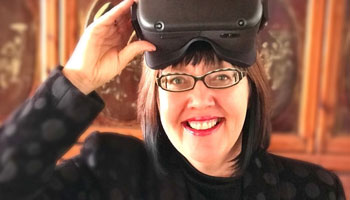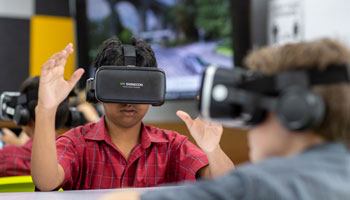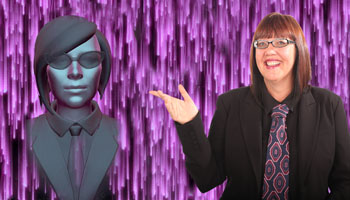Considered a next-frontier technology, virtual reality is now becoming a hands-on application for learning with stellar potential.
A group of Year 5-6 students from a South Australian school is studying Italian. The students learn the language by engaging in instruction similar to lessons in any Australian language class. However, when it comes to demonstrating mastery of the Italian language and cultural knowledge, the program takes an interesting shift.
To assess learning outcomes, the students take their peers, teachers and parents on a tour of Italy that they have created through a platform designed for 360-degree virtual world-building. Some students create 360-degree trips to the Leaning Tower of Pisa. One student returns to her hotel each night where she can plan her itinerary for the following day. All students are using virtual reality technology as part of the assessment criteria.

Professor Erica Southgate, a virtual reality specialist researching its benefits to student learning.
“Students have to think in much more cognitively sophisticated ways. They have to research and collaborate with others and understand the properties of the technology as well as be able to think about the experience of the virtual worlds they’re creating."
“It’s very different from a PowerPoint presentation or making a cardboard box model,” says Associate Professor Erica Southgate, a virtual reality (VR) and artificial intelligence expert at the University’ of Newcastle's School of Education.
“Students have to think in much more cognitively sophisticated ways. They have to research and collaborate with others and understand the properties of the technology as well as be able to think about the experience of the virtual worlds they’re creating and sharing. Students need to consider what is important for others to know and learn.
“They can develop those worlds using linear narratives or nonlinear narratives so it gives them a chance to create their own adventures – they certainly need higher-order thinking to create those sorts of narratives and so it pushes students to think in divergent ways.”

The idea is to think about what is developmentally appropriate for the learner. Image: Bishop Druitt College.
“I’m interested in understanding the learning affordances or properties of emerging technologies - the safety and ethical implications, their relationship to curriculum and pedagogy, and how we might leverage them for improved learning outcomes. All my research in the field involves investigating these aspects with teachers in their classrooms."
Immersive learning is not new, but immersive learning created by the students, that takes them to places and experiences far beyond the current realms of possibilities through digital storyboarding is becoming a reality.
The first commercially accessible virtual reality applications came with Google Cardboard in 2014 (before then most VR was still being explored in military, health and university labs). In 2018, all-in-one VR headsets, which did not require tethering to a computer to work, were made available. But as the technology progresses, so do the questions, the concerns, the ideas and the excitement around how VR can become a useful classroom tool.
“When we think about this type of technology, we forget that for schools it actually hasn’t been around very long – it’s a young technology and so we are still learning about what it’s good for in schools.”
Professor Southgate, who is a keynote presenter at the upcoming AISNSW ICT Management and Leadership Conference in June is a leader in the field. Her work is focused on how VR can improve classroom teaching and learning.
“I’m interested in understanding the learning affordances or properties of emerging technologies - the safety and ethical implications, their relationship to curriculum and pedagogy and how we might leverage them for improved learning outcomes. All my research in the field involves investigating these aspects with teachers in their classrooms,” Professor Southgate says.
As Chief Investigator of the VR School Study she has been exploring the use of immersive virtual reality in real classrooms since 2016. The study aims to build an evidence base through the sharing of resources and reports to ultimately enhance student engagement and learning outcomes. The core topics guiding the study include:
- pedagogy
- curriculum
- assessment
- student Learning
- teacher professional learning
- ethics and safety
- organisational arrangements and culture.
“There is evidence that virtual reality is very good for particular types of learning. If we can design applications or develop sandbox applications for users to create in VR then certain types of learning are facilitated,” she says.
“When you’re in VR you can see the world through another’s eyes, through the eyes of a child, for someone who has neurodiversity for example, through the eyes of someone who is in a refugee camp.”
Already VR is being recognised as an excellent learning support for understanding 3D spatial concepts, for developing empathy, and what Professor Southgate calls embodied cognition where students “feel” learning and understand it through experiences that they are given or create themselves.
“When you’re in VR you can see the world through another’s eyes, through the eyes of a child, for someone who has neurodiversity for example, through the eyes of someone who is in a refugee camp.”
When pitched like that the applications are vast. Science, Art, Drama, Healthcare, History, Psychology, Anthropology (the list is limitless) could all benefit from the technology.
Professor Southgate’s understanding of its potential in education deepened during a technical conference in Japan pre-COVID. Goggled and suspended in a harness, she was surrounded by a school of fish. Asked to become one of the fish, her quest was to swim as fast as she could to remain with the school to avoid being picked off by a predator.

Professor Erica Southgate is Chief Investigator of the VR School Study.
“Scale can be manipulated to the size of a human cell and in VR you can travel through the body as a cell, or be transported to a place that doesn’t exist anymore in history or you can go inside a volcano, for instance, and look at how the natural world works.”
‘As soon as I put on the headset I thought, ‘Wow. This is going to transform education. Immersive learning will be really powerful in the future’.
“What you gain from this experiential learning is the concept of instinct, which is quite an abstract idea. You learn it through your body, you learn it affectively through emotional responses and you learn it cognitively as well.
“The other thing VR is good at doing is peeling back layers of the world and being able to show things you can’t normally see,” Dr Southgate says.
“Scale can be manipulated to the size of a human cell and in VR you can travel through the body as a cell, or be transported to a place that doesn’t exist anymore in history or you can go inside a volcano, for instance, and look at how the natural world works.”
Professor Southgate says the learning does not just come through the experiences offered but through student content creation. With the recent review of Pathways for senior secondary students, the technology could open the way for a plethora of new employment opportunities.
“VR apps are created through multi interdisciplinary teams – computer scientists, graphic artists, sound engineers, content developers, storytellers – people who are part of the narrative, and for education applications it includes teachers.
“The idea is to think about what is developmentally appropriate for the learner, what’s technologically appropriate and accessible for them, and how the teacher might be able to leverage the pedagogies they already use in class with a virtual reality experience."
“It takes a big team to develop good apps but what’s more interesting to me as an educator is how do we create toolboxes or sandboxes with authoring tools for students to create their own virtual worlds in ways that are easy and accessible and don’t require coding knowledge?” she says.
“The idea is to think about what is developmentally appropriate for the learner, what’s technologically appropriate and accessible for them, and how the teacher might be able to leverage the pedagogies they already use in class with a virtual reality experience and to put students at the centre of that content creation.”
And this is where virtual learning for students becomes the reality.
New to AISNSW and want to receive AISNSW Education News updates? Click here to register, and select ‘AISNSW Education News’ on the Areas of Interest/Subscriptions page.